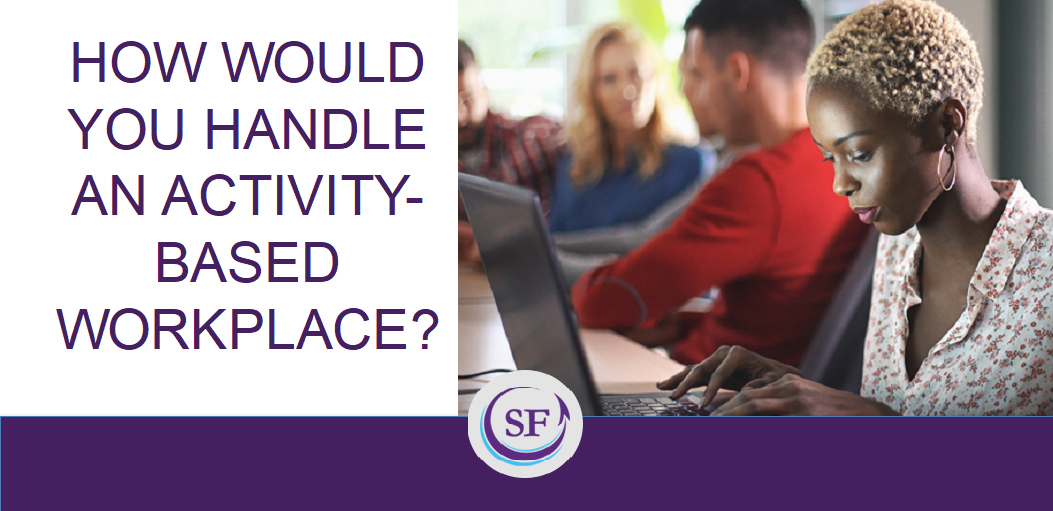Imagine you have worked in the same work setting for years, nested in your office or cubicle filled with your favorite photos and a plant you’ve nurtured despite fluorescent lights. Now you learn that your company is moving to an activity-based work environment — also referred to as “hot-desking.”
No more desk, let alone your own office or cubicle. No desktop computer with sticky notes reminding you to smile. Now, each morning you will go to your assigned locker, gather your “stuff” and find a place to work in a free-seating setting where 150 of your co-workers are also choosing the space where they will work for the day.
In a recent survey, 66% of 400 Asia-Pacific companies declared they are moving to activity-based workplaces by 2020. You might expect to see these transformational workplaces at the Googles of the world. But if you work for a more traditional company, you might be freaked out when you are told to abandon your personal space and radically change the way you work.
I recently had the opportunity to work with an organization whose employees are in varying degrees of denial and panic as their entire work life is about to be upended. After seeing renderings of the new workspace laid out like a library, with a variety of tables and groupings, employees expressed their fears and concerns.
- Not knowing where I’m going to sit when I walk in the door each day adds the pressure of another decision I have to make.
- What if I prefer a certain space, but when I get there, it’s taken?
- I’m afraid cliques will form. All the cool kids will stake out an area exclude me.
- I guess if I sit next to someone who bugs me, I can get up and move somewhere else. But I’m already exhausted thinking about facing that unknown possibility every day.
- I’m worried about being able to focus with all the distractions.
- Losing my office means losing status and power.
Listening to employees’ reactions, the science of motivation has never been more relevant. Consider how a workplace designed for ABW potentially erodes the three psychological needs required for thriving at work.
The need for choice (autonomy). The argument is that an ABW environment gives you ultimate choice. After all, you get to choose where to sit every day, right? But you may not have a perception of choice because, if you could choose, you’d prefer a private space that you can personalize. You also wouldn’t choose the potential daily disruptions over a comforting routine. Your perception of choice is also eroded because you didn’t have control over the decision to move from a traditional workplace structure to the open, community-based one.
The need for connection (relatedness). The rationale for the new ABW setting is that it promotes collaboration, breaks down the hierarchy, creates community and stimulates cross-functional innovation — all of which should satisfy your need for connection and belonging. Even if you appreciate the idea of building community and being exposed to other people’s jobs that can promote empathy and creativity, you may be more fearful of being marginalized, handling awkward situations or having to deal with people you don’t like.
The need for competence. An underlying premise of ABW is that people learn more by rubbing elbows with people who were stuck in a silo. You might find the day-to-day variety exciting as you sit next to the accounts payable clerk one day and the CEO the next. But it’s the little nagging questions that tend to erode your competence. You are unsure about the protocol for asking the person sitting next to you to lunch, especially if it’s the CEO. How do you handle phone calls? Do you have to whisper into the phone or run to another area? What if you need your computer for the call — do you lug your computer with you? How do you suddenly function without paper or all your reference materials?
The science of motivation explains why your sense of well-being is threatened, as ABW is bound to challenge anyone’s psychological needs. However, motivation science can also provide an antidote. When you are faced with a major change, improve your chances of experiencing choice, connection and competence by asking:
- How do I awaken choice? Recognize you always have a choice and some control within stated boundaries. Take control over your own responses to the new situation. Choose to focus on connection and competence.
- How do I awaken connection? Find ways to act on your values and work-related purpose. Think bigger by focusing on how you can contribute to and build a community for the greater good. Advocate for changes or improvements that promote justice and fair play.
- How do I awaken competence? Appreciate what you might learn from this experience. Share what you learn with others who need direction or support. Be grateful for the opportunity to grow, demonstrate resilience, and gain wisdom from the experience.
Addressing your personal concerns by satisfying your psychological needs will help you successfully adapt to major change such as an activity-based workplace. As the world changes, perhaps your most important skill is learning to master your motivation by recognizing the opportunities you have to make choices, deepen connections, and build competence.
Susan Fowler is the co-author of the newly revised “Self Leadership and The One Minute Manager” with Ken Blanchard and Laurence Hawkins, and lead developer of The Ken Blanchard Companies’ Self Leadership product line. She is also the author of the bestseller “Why Motivating People Doesn’t Work… and What Does.” Fowler is a senior consulting partner at The Ken Blanchard Cos. and a professor in the Master of Science in Executive Leadership Program at the University of San Diego.
If you enjoyed this article, sign up for SmartBrief’s free e-mail on leadership and communication, among SmartBrief’s more than 200 industry-focused newsletters.
